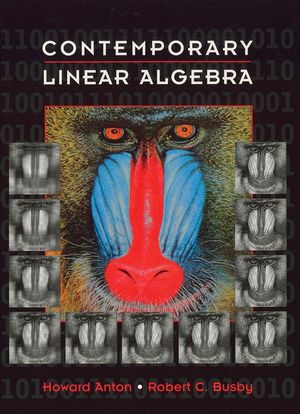|
Textbook
Contemporary Linear AlgebraISBN: 978-0-471-16362-6
Hardcover
656 pages
September 2002, ©2003
 |
||||||
CHAPTER 1 Vectors 1
1.1 Vectors and Matrices in Engineering and Mathematics; n-Space 1
1.2 Dot Product and Orthogonality 15
1.3 Vector Equations of Lines and Planes 29
CHAPTER 2 Systems of Linear Equations 39
2.1 Introduction to Systems of Linear Equations 39
2.2 Solving Linear Systems by Row Reduction 48
2.3 Applications of Linear Systems 63
CHAPTER 3 Matrices and Matrix Algebra 79
3.1 Operations on Matrices 79
3.2 Inverses; Algebraic Properties of Matrices 94
3.3 Elementary Matrices; A Method for Finding A−1 109
3.4 Subspaces and Linear Independence 123
3.5 The Geometry of Linear Systems 135
3.6 Matrices with Special Forms 143
3.7 Matrix Factorizations; LU-Decomposition 154
3.8 Partitioned Matrices and Parallel Processing 166
CHAPTER 4 Determinants 175
4.1 Determinants; Cofactor Expansion 175
4.2 Properties of Determinants 184
4.3 Cramer’s Rule; Formula for A −1; Applications of Determinants 196
4.4 A First Look at Eigenvalues and Eigenvectors 210
CHAPTER 5 Matrix Models 225
5.1 Dynamical Systems and Markov Chains 225
5.2 Leontief Input-Output Models 235
5.3 Gauss–Seidel and Jacobi Iteration; Sparse Linear Systems 241
5.4 The Power Method; Application to Internet Search Engines 249
CHAPTER 6 Linear Transformations 265
6.1 Matrices as Transformations 265
6.2 Geometry of Linear Operators 280
6.3 Kernel and Range 296
6.4 Composition and Invertibility of Linear Transformations 305
6.5 Computer Graphics 318
CHAPTER 7 Dimension and Structure 329
7.1 Basis and Dimension 329
7.2 Properties of Bases 335
7.3 The Fundamental Spaces of a Matrix 342
7.4 The Dimension Theorem and Its Implications 352
7.5 The Rank Theorem and Its Implications 360
7.6 The Pivot Theorem and Its Implications 370
7.7 The Projection Theorem and Its Implications 379
7.8 Best Approximation and Least Squares 393
7.9 Orthonormal Bases and the Gram–Schmidt Process 406
7.10 QR-Decomposition; Householder Transformations 417
7.11 Coordinates with Respect to a Basis 428
CHAPTER 8 Diagonalization 443
8.1 Matrix Representations of Linear Transformations 443
8.2 Similarity and Diagonalizability 456
8.3 Orthogonal Diagonalizability; Functions of a Matrix 468
8.4 Quadratic Forms 481
8.5 Application of Quadratic Forms to Optimization 495
8.6 Singular Value Decomposition 502
8.7 The Pseudoinverse 518
8.8 Complex Eigenvalues and Eigenvectors 525
8.9 Hermitian, Unitary, and Normal Matrices 535
8.10 Systems of Differential Equations 542
CHAPTER 9 General Vector Spaces 555
9.1 Vector Space Axioms 555
9.2 Inner Product Spaces; Fourier Series 569
9.3 General Linear Transformations; Isomorphism 582
APPENDIX A How to Read Theorems A1
APPENDIX B Complex Numbers A3
ANSWERS TO ODD-NUMBERED EXERCISES A9
PHOTO CREDITS C1
INDEX I-1



